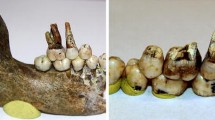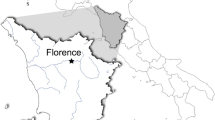Abstract
Skeletal pathologies and oral disease are largely unexplored in fossil carnivores. Dental abnormalities, fractures, trauma, supernumerary teeth, tumours, periodontitis, and other bacterial infections are some of the diseases that leave traces on fossilized skulls, but their identification is not always possible by external observation on the specimen. Moreover a large number of pathologies are “hidden”, partially or completely invisible on the external surface of the bones because their development took place within the bones. The degree and the type of fossilization, the state of preservation and the fossil size are just a few other factors that influence the analysis of these structures. Digital scanning techniques are useful to solve such difficulties. X-ray study can provide valuable information on bone and teeth diseases, by allowing the visualization of the internal structure of the fossil bones, without the alteration and/or destruction of the specimen. Many aspects of the life of carnivores are regulated by their health condition, and in particular by the teeth and jaws conditions, individuals with evident disability due to the pathology and injuries are not able to perform properly some basic activities, such as foraging and defence. This paper presents new methods of non-invasive analysis to identify and understand oral pathologies in fossil carnivores. They can be further explored to obtain detailed palaeoecological reconstructions of their mode of life.
Kurzfassung
Skelett-Pathologien und Mundhöhlenerkrankungen bei fossilen Fleischfressern sind größtenteils unerforscht. Zahnanomalien, Frakturen, Traumata, überzählige Zähne, Tumore, Parodontitis und andere bakterielle Infektionen sind nur einige der Krankheiten, die Spuren auf versteinerten Schädeln hinterlassen, aber ihre Identifizierung ist nicht immer durch eine äußere Beobachtung der Probe möglich. Zudem ist eine große Anzahl von Pathologien “versteckt”, teilweise oder vollständig auf der äußeren Oberfläche der Knochen unsichtbar, da sich ihre Entstehung in den Knochen vollzog. Der Grad und die Art der Versteinerung, der Erhaltungszustand und die Größe des Fossils sind nur einige der Faktoren, welche die Analyse dieser Strukturen beeinflussen. Digitale Scan-Techniken sind dabei durchaus nützlich, solche Schwierigkeiten zu lösen. Mithilfe der Röntgenuntersuchung können wertvolle Informationen über Knochen-und Zahnerkrankungen im Inneren des fossilen Knochenaufbaus dargestellt werden, ohne die jeweilige Probe zu beeinträchtigen und/oder zu zerstören. Viele Aspekte des Lebens von Fleischfressern können an ihren gesundheitlichen Zustand festgestellt werden, insbesondere an dem Zahn - und Kieferzustand. Individuen mit einer erwiesenen Behinderung dieser Strukturen aufgrund von Pathologien und Verletzungen sind nicht in der Lage, einige grundlegende Aktivitäten wie Nahrungssuche und Abwehr ordnungsgemäß durchzuführen. Diese Abhandlung erörtert neue Methoden der nicht-invasiven Analyse, um Mundhöhlenerkrankungen bei fossilen Fleischfressern zu identifizieren und zu verstehen. Sie können somit weitergehend untersucht werden, um eine detaillierte paläoökologische Rekonstruktionen ihrer Lebensweise zu erhalten.




Similar content being viewed by others
References
Abel, R.L., Laurini, C.R., and Richter, M. 2012. A palaeobiologist’s guide to ‘virtual’ micro-CT preparation. Palaeontologia Electronica 15(2): 6T,17p. http://palaeo-electronica.org/content/issue-2-2012-technical-articles/233-micro-ct-workflow.
Aufterheide, A.C. and Rodrìguez-Martìn, C. 2006. The Cambridge Enciclopedia of human paleopathology. London: Cambridge University Press.
Baker, J.R., and D. Brothwell. 1980. Animal diseases in archaeology. New York: Academic Press.
Benton, M.J. 2005. Vertebrate palaeontology. Bristol: Blackwell Publishing, University of Bristol.
Brothwell, D.R. 1967. The Evidence of Neoplasms. In Diseases in Antiquity, ed. Brothwell, D.R. and Sandison, A.T., 320–345. Springfield.
Carranza, F.A., Klokkevold, P.R., Takei, H.H. and Newman, M.G. 2011. Parodontologia Clinica. Antonio Delfino Editore.
Cline, H.E., W.E. Lorensen, S. Ludke, C.R. Crawford, and B.C. Teeter. 1998. Two algorithms for the three-dimensional construction of tomograms. Medical Physics 15: 320–327. doi:10.1118/1.596225.
Conroy, G., and M. Vannier. 1991. Dental development in South African australopithecines. Part II: dental stage assessment. American Journal of Physical Anthropology 86: 137–156. doi:10.1002/ajpa.1330860205.
Dean, M.C., M.E. Jones, and J.R. Pilley. 1992. The natural history of tooth wear, continuous eruption and periodontal disease in wild shot great apes. Journal of Human Evolution 22: 23–39. doi:10.1016/0047-2484(92)90027-7.
DeBowes, L.J. 2000. Dentistry: periodontal aspects. In Textbook of veterinary internal medicine: diseases of the dog and cat, (5th edition), ed. S.J. Ettinger, and E.C. Feldman, 1127–1142. Philadelphia: Saunders.
Ferretti, M.P. 1999. Tooth enamel structure in the hyaenid Chasmaporthetes lunensis lunensis from the Late Pliocene of Italy, with implications for feeding behaviour. Journal of Vertebrate Paleontology 19: 767–770. doi:10.1080/02724634.1999.10011189.
Ferretti, M.P. 2007. Evolution of bone-cracking adaptations in hyaenids (Mammalia, Carnivora). Swiss Journal of Geoscience 100: 41–52. doi:10.1007/s00015-007-1212-6.
Goillot, C., C. Blondel, and S. Peigné. 2009. Relationship between dental microwear and diet in Carnivora (Mammalia)—Implications for the reconstruction of the diet of extinct taxa. Palaeogeography, Palaeoclimatology, Palaeoecology 271: 13–23. doi:10.1016/j.palaeo.2008.09.004.
Greer, M., J.K. Greer, and J. Gillingham. 1977. Osteoarthritis in selected wild mammals. Proceedings from the Oklahoma Academy of Science 57: 39–43.
Horwitz, L.K., and G. Davidovitz. 1992. Dental pathology of wild pigs (Sus scrofa) from Israel. Israel Journal of Zoology 38: 111–123.
Iurino, D.A., R. Fico, M. Petrucci, and R. Sardella. 2013a. A pathological Late Pleistocene canid from San Sidero (Italy): implications for social- and feeding-behaviour. Naturwissenschaften 100(3): 235–243. doi:10.1007/s00114-013-1018-5.
Iurino, D.A., Danti, M., Della Sala, S.W. and Sardella, R. 2013b. Modern techniques for ancient bones: Vertebrate Palaeontology and medical CT analysis. Bollettino della Società Paleontologica Italiana, (published online). doi:10.4435/BSPI.2013.13.
Johnson, K.A., and A.D. Watson. 2000. Skeletal diseases. In Textbook of veterinary internal medicine: diseases of the dog and cat, (5th edition), ed. S.J. Ettinger, and E.C. Feldman, 1887–1916. Philadelphia: Saunders.
Lovell, N.C. 1997. Trauma in Paleopathology. Yearbook of Physical Anthropology 40: 139–170.
Martínez-Navarro, B., and L. Rook. 2003. Gradual evolution in the African hunting dog lineage systematic implications. C R Palevol 2: 695–702. doi:10.1016/j.crpv.2003.06.002.
Meloro, C. 2012. Mandibular shape correlates of tooth fracture in extant Carnivora. Implications to infer feeding behaviour of Rancho La Brea predators. Biological Journal of the Linnean Society 106: 70–80. doi:10.1111/j.1095-8312.2011.01843.x.
Miles, A.E.W., and C. Grigson. 2003. Colyer’s variations and diseases of the teeth of animals. Cambridge: Cambridge University Press.
Moodie, R.L. 1917. Studies in paleopathology, general consideration of the evidences of pathological conditions found among fossil animals. Cambridge: Annal of Medical History, Harvard University.
Newton, J.E., and C. Jackson. 1984. The effect of age on tooth loss and the performance of masham ewes. Animal Production 39: 421–425.
Olejniczak, A., P. Tafforeau, R. Feeney, and L. Martin. 2008. Three-dimensional primate molar enamel thickness. Journal of Human Evolution 54: 187–195. doi:10.1016/j.jhevol.2007.09.014.
Palmqvist, P., A. Arribas, and B. Martínez-Navarro. 1999. Ecomorphological study of large canids from lower Pleistocene of southeastern Spain. Lethaia 32: 75–88. doi:10.1111/j.1502-3931.1999.tb00583.x.
Resnick, D., and M.J. Kransdorf. 2005. Bone and joint imaging. Philadelphia: Elsevier Saunders.
Resnick, D., and G. Niwayama. 1988. Diagnosis of bone and joint disorders. Philadelphia: Saunders.
Roberts, C., and K. Manchester. 2005. The archaeology of disease, 3rd ed. Ithaca: Cornell University Press.
Ronan, R., R.L. Abel, K. Johnson, and C. Perry. 2010. Quantification of porosity in Acropora pulchra (Brook 1891) using X-ray micro-computed tomography techniques. Journal of Experimental Marine Biology and Ecology 396: 1–9. doi:10.1016/j.jembe.2010.10.006.
Rossi, M., F. Casali, D. Romani, L. Bondioli, R. Macchiarelli, and L. Rook. 2004. MicroCT Scan in paleobiology: application to the study of dental tissues. Nuclear Instruments and Methods in Physics Research Section B 213: 747–750. doi:10.1016/S0168-583X(03)01697-5.
Rothschild, B.M. 1982. Rheumatology: a primary care approach. New York: Yorke Medical Press.
Rothschild, B.M. 2002. Contributions of paleorheumatology to understand contemporary disease. Rheumatismo 54(3): 272–284.
Rothschild, B. and Martin, L. D. 2006. Skeletal impact of disease. New Mexico Museum of natural history and science bulletin no. 33.
Schwartz, G. 2000. Taxonomic and functional aspects of the patterning of enamel thickness distribution in extant large-bodied hominoids. American Journal of Physical Anthropology 111: 221–244. doi:10.1002/(SICI)1096-8644(200002)111:2<221:AID-AJPA8>3.0.CO;2-G.
Stefen, C. 2001. Enamel structure of arctoid Carnivora: Amphicyonidae, Ursidae, Procyonidae and Mustelidae. Journal of Mammalogy 82(2): 450–462. doi:10.1644/1545-1542(2001)082<0450:ESOACA>2.0.CO;2.
Sutton, M.D. 2008. Tomographic techniques for the study of exceptionally preserved fossils. Proceedings of the Royal Socety B 275: 1587–1593. doi:10.1098/rspb2008.0263.
Thomas, R., Davies, J. and Fabiš, M. 2002. Beyond “interesting specimens”: palaeopathology and its contribution to the study of animal husbandry. Session Abstract. Book of Abstracts for the International Council of Archaeozoology, 9th conference. University of Durham.
Xu, F., and K. Mueller. 2005. Accelerating popular tomographic reconstruction algorithms on commodity PC graphics hardware. IEEE Transactions on Nuclear Science 52: 654–663. doi:10.1109/TNS.2005.851398.
Van Valkenburgh, B. 1988. Incidence of tooth breakage among large, predatory mammals. American Naturalist 131: 291–302.
Van Valkenburgh, B., and F. Hertel. 2003. Tough times at La Brea: tooth breakage in large carnivores of the late Pleistocene. Science 261(5120): 456–459. doi:10.1126/science.261.5120.456.
Van Valkenburgh, B. 2009. Cost of carnivory: tooth fracture in Pleistocene and recent carnivores. Biological Journal of the Linnean Society 96: 68–81. doi:10.1111/j.1095-8312.2008.01108.x.
Waldron, T. 2009. Palaeopathology. Cambridge: Cambridge University Press.
Acknowledgments
We would like to thank Dr. M. Danti and Prof. S. Della Sala (Ospedale M. G. Vannini) for making the CT scanning and Dr. L. Santini (Sapienza University of Rome) for his useful suggestions and help. The authors also express their gratitude to the anonymous reviewer who greatly improved this article with constructive criticisms, comments and suggestions.
Author information
Authors and Affiliations
Corresponding author
Rights and permissions
About this article
Cite this article
Iurino, D.A., Sardella, R. Medical CT scanning and the study of hidden oral pathologies in fossil carnivores. Paläontol Z 89, 251–259 (2015). https://doi.org/10.1007/s12542-013-0220-2
Received:
Accepted:
Published:
Issue Date:
DOI: https://doi.org/10.1007/s12542-013-0220-2




